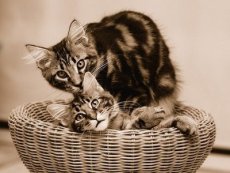New publications
Hairballs in cats' stomachs
Last reviewed: 06.07.2025

All iLive content is medically reviewed or fact checked to ensure as much factual accuracy as possible.
We have strict sourcing guidelines and only link to reputable media sites, academic research institutions and, whenever possible, medically peer reviewed studies. Note that the numbers in parentheses ([1], [2], etc.) are clickable links to these studies.
If you feel that any of our content is inaccurate, out-of-date, or otherwise questionable, please select it and press Ctrl + Enter.

Hairballs in cats are certainly an unpleasant occurrence. They aren't just unpleasant for the person who removes them. They can cause intestinal blockages, which can seriously harm your cat's health. If your cat is a self-grooming cat, what can you do to minimize hairballs?
What causes hairballs in cats?
Hairballs, technically called hairballs, can be gross, especially on your white rug, but they're the result of your cat's healthy, meticulous grooming habits.
When a cat grooms itself, small hook-like structures on its tongue catch loose and dead hairs, which are then swallowed. Most of these hairs pass through the digestive tract unimpeded. But if the hairs remain in the stomach, they can form a hairball. The cat eventually regurgitates the hairball to get rid of it. Because hairballs pass through the narrow esophagus on their way out, they are often thin and tube-shaped rather than round.
Hairballs are more likely to form in long-haired breeds, such as Persians and Maine Coons. Cats that shed heavily or compulsively groom themselves are also more likely to develop hairballs because they ingest a lot of hair. You may have noticed that your cat didn't have hairballs when she was a kitten, but they started to develop them as she grew older. This is completely normal—as cats get older, they become better groomers and are therefore more thorough in removing hair with their tongues. This means you'll have more hairballs to clean up.
Hairball Symptoms in Cats
It can be disgusting to watch (and hear) a cat regurgitate a hairball. Common symptoms include coughing, gagging, and vomiting. The cat will then usually regurgitate the hairball relatively quickly.
If you notice any of the following hairball symptoms, be sure to contact your veterinarian as they may indicate that the hairball has caused a potentially life-threatening blockage:
- Prolonged vomiting, gagging, or coughing that does not pass the hairball
- Lack of appetite
- Drowsiness
- Constipation
- Diarrhea
Four Hairball Remedies
There is nothing you can do to completely prevent hairballs in cats, but you can reduce the likelihood or frequency of their occurrence.
- Brush your cat's fur regularly. The more fur you brush out, the less fur will be left behind as the starting material for lint balls. Daily brushing or combing can be effective in reducing lint balls, and it's also a fun way to interact with your cat. If you can't get your cat used to being groomed or brushed, consider having a professional groomer and trimmer (especially for long-haired cats) every six months or so.
- Feed your cat a special food formulated to reduce hairballs. Many pet food manufacturers now produce cat foods designed to reduce hairballs. These high-fiber formulas are designed to improve the health of your cat's coat, reduce hair loss, and help the hairballs pass through the digestive system.
- Use a hairball remover or laxative. There are a number of different hairball products on the market today, most of which are mild laxatives that help the hairballs pass through the digestive tract.
- Discourage excessive grooming. If you suspect your cat's hairballs are the result of compulsive grooming, try teaching your cat another enjoyable activity. You can teach your cat to play with a new toy on its own, or find a fun toy that you can play with together.
